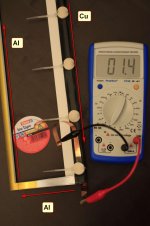Hi everyone!
I show here my idea of a flat fullrange bendingwave driver.
I do not follow this path any further since I failed to find a company willingly producing this speaker. This tells something…
I know that a lot of skilled people will reading this. I invite you to discuss about it here, but I am out of power by now. I present my idea “as it is” that others may finding this useful to some extend, or even will continue my work. All text attachments will be only in German, sorry about that.
This voicecoil can be used in other loudspeaker design as well. Voicecoil priority DE 10 2017 004 832.0 is ending 18 May 2018, and a German patent on this loudspeaker will falling by midsummer, so I am not in the way to new implementations. It use the same physics like in piston speakers, but whole design is new and advanced, some will say over the top?
Here is what I’ve got to contribute:
Main concerns:
Applications:
Applications depending on final performance of a full developed prototype. At the moment it basically shows the design is working as intended, and it is possible to produce a linear voicecoil special to operate in this type of loudspeaker. No CAD simulations and no measurements yet, still to tame a lot by changing membrane thickness versus local weight.
Loudspeaker Modeling:
A good starting point would be the membrane, which was in my case fully arbitrary designed and made of material available to me. So their may possibilities to reduce weight which gain sensitivity and HF response and lead to better damping.
Crucial is low area weight, thus laminates that are extremely thin get in use. Ud-carbon laminates offer the best weight to stiffness ratio, for the inner sandwich maybe Nomex is substituted by polymer-foam with better damping properties and also less weight. Not sure which is better, true and reliable lists of material properties are difficult to get. A quick internet search show ud-CFC 50g/m2 available, tailor-made can it be even lighter. There is no way around CFC, and you need a sophisticated layer structure to reduce dead weight, different resin matrix are to choose from.
Overall length of membrane depending on material stiffness, as well as distance from fix-point to voicecoil-contact on membrane. Cross section of membrane defines the SPL over frequency, as weight to stiffness ratio does. This has to be modeled by FEA within limits of membrane production line. Overall height of membrane defines maximum volume displacement, as well as vertical beaming. Effective membrane surface area limits maximum SPL.
Voicecoil is overhung type, with little to mediocre excursions that will be amplified by membrane lever to big excursions. Voicecoil connection to membrane can be made better, with lots of little cuts to give better adhesion to membrane and prevent currant flow out of magnetic gap. Glue excess has to be removed since dead weight reduces HF response (as in my prototype) Finally, as last trick, additional capacitors lift the upper end above 20kHz.
SoundBlade
I show here my idea of a flat fullrange bendingwave driver.
I do not follow this path any further since I failed to find a company willingly producing this speaker. This tells something…
I know that a lot of skilled people will reading this. I invite you to discuss about it here, but I am out of power by now. I present my idea “as it is” that others may finding this useful to some extend, or even will continue my work. All text attachments will be only in German, sorry about that.
This voicecoil can be used in other loudspeaker design as well. Voicecoil priority DE 10 2017 004 832.0 is ending 18 May 2018, and a German patent on this loudspeaker will falling by midsummer, so I am not in the way to new implementations. It use the same physics like in piston speakers, but whole design is new and advanced, some will say over the top?
Here is what I’ve got to contribute:
- design: flat planar speaker, low coincidence frequency
- type of operation: 1-dimensional wave guide, bendingwave and piston like
piston underneath coincidence-frequency, over non reflective bending modes - acoustic properties: linesource, coherent cylindrical wave front
room filling dispersion over 180 degrees horizontal - motor: magnetodynamic actuator, linear voicecoil, flux modulation canceling back currant
opportunity for impedance compensation by capacitors - membrane: ud-CFC laminate sandwich, Nomex honeycomb or polymer-foam,
no surround – as big excursions are expected at low frequency - thermal expansion coefficient: ud-CFC ≈ [FONT=Albany, sans-serif]Al[/FONT]
Main concerns:
- high frequency extension to at least 20kHz
- smooth frequency range and dispersion
- surround airtight sealing
Applications:
- home audio, flat TV-screen supplement, automotive (in door vertically)
- OB, IB, vented, passive radiator, compound
- we don’t know yet...
Applications depending on final performance of a full developed prototype. At the moment it basically shows the design is working as intended, and it is possible to produce a linear voicecoil special to operate in this type of loudspeaker. No CAD simulations and no measurements yet, still to tame a lot by changing membrane thickness versus local weight.
Loudspeaker Modeling:
A good starting point would be the membrane, which was in my case fully arbitrary designed and made of material available to me. So their may possibilities to reduce weight which gain sensitivity and HF response and lead to better damping.
Crucial is low area weight, thus laminates that are extremely thin get in use. Ud-carbon laminates offer the best weight to stiffness ratio, for the inner sandwich maybe Nomex is substituted by polymer-foam with better damping properties and also less weight. Not sure which is better, true and reliable lists of material properties are difficult to get. A quick internet search show ud-CFC 50g/m2 available, tailor-made can it be even lighter. There is no way around CFC, and you need a sophisticated layer structure to reduce dead weight, different resin matrix are to choose from.
Overall length of membrane depending on material stiffness, as well as distance from fix-point to voicecoil-contact on membrane. Cross section of membrane defines the SPL over frequency, as weight to stiffness ratio does. This has to be modeled by FEA within limits of membrane production line. Overall height of membrane defines maximum volume displacement, as well as vertical beaming. Effective membrane surface area limits maximum SPL.
Voicecoil is overhung type, with little to mediocre excursions that will be amplified by membrane lever to big excursions. Voicecoil connection to membrane can be made better, with lots of little cuts to give better adhesion to membrane and prevent currant flow out of magnetic gap. Glue excess has to be removed since dead weight reduces HF response (as in my prototype) Finally, as last trick, additional capacitors lift the upper end above 20kHz.
SoundBlade
Attachments
-
Lautsprecher Expose_SdB_2013.pdf297.8 KB · Views: 177
-
 SdB_2017_5_flex.jpg219.3 KB · Views: 245
SdB_2017_5_flex.jpg219.3 KB · Views: 245 -
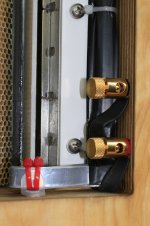 SdB_2017_4_con.jpg235 KB · Views: 241
SdB_2017_4_con.jpg235 KB · Views: 241 -
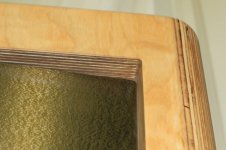 SdB_2017_3_edge.jpg223 KB · Views: 471
SdB_2017_3_edge.jpg223 KB · Views: 471 -
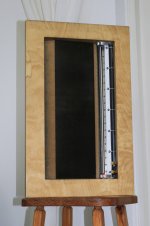 SdB_2017_2_back.jpg194.1 KB · Views: 475
SdB_2017_2_back.jpg194.1 KB · Views: 475 -
 SdB_2017_1_front.jpg301 KB · Views: 472
SdB_2017_1_front.jpg301 KB · Views: 472 -
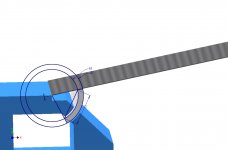 M_out_SdB.jpg104.5 KB · Views: 476
M_out_SdB.jpg104.5 KB · Views: 476 -
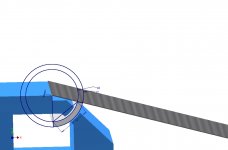 M_in_SdB.jpg100 KB · Views: 478
M_in_SdB.jpg100 KB · Views: 478 -
Linearspule Expose_SdB_2017.pdf960.6 KB · Views: 119
-
Datenblatt-FLS1_SdB_2017.pdf273 KB · Views: 142
@altie
Yes, I did. In a early stage of this speaker I mailed to every company in germany and some in europe with only few responses. I showed up at 2 german companies and a really big one in benelux (!). That time I had no solution to produce the voicecoil special needed in this speaker. So I developed this in 2017 as a prototype. With this I went to a danish/indonesian company, they were kindly listen to me and this speaker. Unfortunately it's a bit out of their product range, but they see some possibilities in it.
@DMLBES
The panel is at frontside to listening room total flat, inside/backwards thickness varies to give stability and to achieve desired FR. The frame got some curves, but not necessarily.
Yes, I did. In a early stage of this speaker I mailed to every company in germany and some in europe with only few responses. I showed up at 2 german companies and a really big one in benelux (!). That time I had no solution to produce the voicecoil special needed in this speaker. So I developed this in 2017 as a prototype. With this I went to a danish/indonesian company, they were kindly listen to me and this speaker. Unfortunately it's a bit out of their product range, but they see some possibilities in it.
@DMLBES
The panel is at frontside to listening room total flat, inside/backwards thickness varies to give stability and to achieve desired FR. The frame got some curves, but not necessarily.
A quick internet search show ud-CFC 50g/m2 available
I would be glad to find that material, could you give some pointers?
Btw, I tried 5mm XPS foam (30kg/m3) sandwiched with 25g/m² glass cloth and in the end I obtained about 200 g/m2. Epoxy resin adds a lot of weight...
How did you glued the unidirectional carbon fibre cloth to the honeycomb?
Last edited:
Do you have any measurements?
Efficiency?
I'm not sure I understand how the motor works?
Looking at the black membrane, it surly looks "curved" given the shadows...? At least at the sides?
//
Efficiency?
I'm not sure I understand how the motor works?
Looking at the black membrane, it surly looks "curved" given the shadows...? At least at the sides?
//
I tried a similar concept almost 20 years ago albeit in a much more crude and less sophisticated form originally just a thin balsa sheet laminated with fiberglass. I would like to understand more the design of the voice coil. I was reading your Linearspule Expose but what means: "WAK passend zum Membran Material CFK".
Why you think that VC weight has to be so extremely optimized as bending wave drivers are not really accelerated as pistonic ones? Is the very low DC resistance not causing problems with most amplifier?
Your description of lack of interest in bending wave driver by the industry is quite discouraging. The loudspeaker industry is apparently only interested in incremental changes (like using some different materials and calling it a mayor technical breakthrough) and does not want to invest in significant new technologies. At least I am still playing and listening to my bending wave drivers.
Why you think that VC weight has to be so extremely optimized as bending wave drivers are not really accelerated as pistonic ones? Is the very low DC resistance not causing problems with most amplifier?
Your description of lack of interest in bending wave driver by the industry is quite discouraging. The loudspeaker industry is apparently only interested in incremental changes (like using some different materials and calling it a mayor technical breakthrough) and does not want to invest in significant new technologies. At least I am still playing and listening to my bending wave drivers.
Last edited:
more
Hi!
@nicotin78
the membrane was built by Start - Invent
cant help you more, but with this Kohlegelege ST 30 g/m2 (UD) 50 cm
online einkaufen ✓ |
R&G Faserverbundwerkstoffe GmbH - Composite Technology (you get 30g/m2)
the anodized Aluminum came from Anofol • ANOFOL
At Steinert they were also extremely helpful in welding Aluminum foil to the copper back wire. There is no current loss 60 connections in series! This connections can be used, since they are already there, to compensate voicecoil inductance. Schematic found on my Linearspule page 5.
I think it is possible to built this membrane much lighter, voicecoil is already reaching it’s physical limits. Best weight to conductance ratio and gap filling volume, no need for a coil former.
@TNT
I don’t have any measurements yet, and probably never will. The voicecoil has a Rdc 1,5 Ohm. I made my pressing tool unfortunately before Steinert told me they can only deliver 0.058 mm foil. Therefore I ended up with this smallish 1,5[FONT=Liberation Serif, serif]Ω[/FONT][FONT=Liberation Serif, serif]. [/FONT]Laserinterferometrie would be extremely interesting, to see how this membrane actually oscillating. Scanning Vibrometer System (SCN)
1st Fundamental mode of this speaker is like a swinging door
This speaker motor is no exception to the rule F = B [FONT=Liberation Serif, serif]∙ [/FONT]I [FONT=Liberation Serif, serif]∙ [/FONT]l
Since I am using stray field magnet I would expect high efficiency with proper magnet system. (in schematic 1 and 2: the blue is magnet circuit, voicecoil is gray) Last picture of today shows current path. Underneath black isolation is back-conductor copper flat cable.
@Monteverdi
"WAK passend zum Membran Material CFK" WAK (Wärmeausdehnungskoeffizient) is German for “thermal expansion coefficient” as this linear voicecoil is getting hot during operation it will become a little longer. This thermal expansion coefficient is nearly same for UD-Carbon in cross direction to fibers this membrane is made of, so it will stay flat and don’t scratch in magnet gap when heating up. But it depending a lot of composite matrix material, epoxy here e. g.
What type of voicecoil did you employ 20 years ago? In this speaker the standard round concentric voicecoil does not work, as membrane is oscillating around a fixed edge, like swinging door. It is a rotary actuator in this case.
If you take a piece of paper and try to bend it over a round opening it starts to wrinkle up. When you bend it in a straight line it bends easy, staying uncreased. That’s why I think NXT bender is not so good for high amplitudes and Manger MSW using soft membrane material.
Yes, this voicecoil inductance is far to low, with thinner foil and or other geometry you will getting perfect 4[FONT=Liberation Serif, serif]Ω.[/FONT]
[FONT=Liberation Serif, serif]Please s[/FONT][FONT=Liberation Serif, serif]tay at your bendingwave drivers, they make you happy, so don’t change anything![/FONT][FONT=Liberation Serif, serif] [/FONT]
@soundBlade
edit: There was one more company interested, a US/Taiwan making mostly portable devices, and hey! they using voicecoil made of Anofol which is quite progressive.
This speaker build was not meant as a commercial product, it’s just a prototype to show the concept is working. Most said that it’s impossible to produce a voicecoil for this type of speaker. I have done it here, but to make it finally to a good speaker there is a lot more to be done. (it’s always a money question, as time and experience too)
Next thing would to build a proper magnet circuit around the voicecoil, it can be easy done by any speaker manufacture around the world. Cost for just one cnc prototype about 400. Then you will have a pretty good efficiency, but still a lot of peaks and dips in FR.
So you have to reconstruct the whole membrane, either the smart way by CAD, FEA or “brute force” by trying different membrane profiles and different prototypes and chose the best.
The whole process to model this speaker is really complicated and expensive. I only can warn any DIY to do this. Most professionals will struggle since their software and production lines will not work here, which partially explains why no company is producing this speaker. There are only 2 companies in Germany that can make thin anodized Aluminum foil and you will need UD-carbon (aerospace grade) in very fine structure. You will need special glue to hot bonding all together and custom-tools and water-cutting, ultrasonic-welding...
SoundBlade
Hi!
@nicotin78
the membrane was built by Start - Invent
cant help you more, but with this Kohlegelege ST 30 g/m2 (UD) 50 cm
online einkaufen ✓ |
R&G Faserverbundwerkstoffe GmbH - Composite Technology (you get 30g/m2)
the anodized Aluminum came from Anofol • ANOFOL
At Steinert they were also extremely helpful in welding Aluminum foil to the copper back wire. There is no current loss 60 connections in series! This connections can be used, since they are already there, to compensate voicecoil inductance. Schematic found on my Linearspule page 5.
I think it is possible to built this membrane much lighter, voicecoil is already reaching it’s physical limits. Best weight to conductance ratio and gap filling volume, no need for a coil former.
@TNT
I don’t have any measurements yet, and probably never will. The voicecoil has a Rdc 1,5 Ohm. I made my pressing tool unfortunately before Steinert told me they can only deliver 0.058 mm foil. Therefore I ended up with this smallish 1,5[FONT=Liberation Serif, serif]Ω[/FONT][FONT=Liberation Serif, serif]. [/FONT]Laserinterferometrie would be extremely interesting, to see how this membrane actually oscillating. Scanning Vibrometer System (SCN)
1st Fundamental mode of this speaker is like a swinging door
This speaker motor is no exception to the rule F = B [FONT=Liberation Serif, serif]∙ [/FONT]I [FONT=Liberation Serif, serif]∙ [/FONT]l
Since I am using stray field magnet I would expect high efficiency with proper magnet system. (in schematic 1 and 2: the blue is magnet circuit, voicecoil is gray) Last picture of today shows current path. Underneath black isolation is back-conductor copper flat cable.
@Monteverdi
"WAK passend zum Membran Material CFK" WAK (Wärmeausdehnungskoeffizient) is German for “thermal expansion coefficient” as this linear voicecoil is getting hot during operation it will become a little longer. This thermal expansion coefficient is nearly same for UD-Carbon in cross direction to fibers this membrane is made of, so it will stay flat and don’t scratch in magnet gap when heating up. But it depending a lot of composite matrix material, epoxy here e. g.
What type of voicecoil did you employ 20 years ago? In this speaker the standard round concentric voicecoil does not work, as membrane is oscillating around a fixed edge, like swinging door. It is a rotary actuator in this case.
If you take a piece of paper and try to bend it over a round opening it starts to wrinkle up. When you bend it in a straight line it bends easy, staying uncreased. That’s why I think NXT bender is not so good for high amplitudes and Manger MSW using soft membrane material.
Yes, this voicecoil inductance is far to low, with thinner foil and or other geometry you will getting perfect 4[FONT=Liberation Serif, serif]Ω.[/FONT]
[FONT=Liberation Serif, serif]Please s[/FONT][FONT=Liberation Serif, serif]tay at your bendingwave drivers, they make you happy, so don’t change anything![/FONT][FONT=Liberation Serif, serif] [/FONT]
@soundBlade
edit: There was one more company interested, a US/Taiwan making mostly portable devices, and hey! they using voicecoil made of Anofol which is quite progressive.
This speaker build was not meant as a commercial product, it’s just a prototype to show the concept is working. Most said that it’s impossible to produce a voicecoil for this type of speaker. I have done it here, but to make it finally to a good speaker there is a lot more to be done. (it’s always a money question, as time and experience too)
Next thing would to build a proper magnet circuit around the voicecoil, it can be easy done by any speaker manufacture around the world. Cost for just one cnc prototype about 400. Then you will have a pretty good efficiency, but still a lot of peaks and dips in FR.
So you have to reconstruct the whole membrane, either the smart way by CAD, FEA or “brute force” by trying different membrane profiles and different prototypes and chose the best.
The whole process to model this speaker is really complicated and expensive. I only can warn any DIY to do this. Most professionals will struggle since their software and production lines will not work here, which partially explains why no company is producing this speaker. There are only 2 companies in Germany that can make thin anodized Aluminum foil and you will need UD-carbon (aerospace grade) in very fine structure. You will need special glue to hot bonding all together and custom-tools and water-cutting, ultrasonic-welding...
SoundBlade
Attachments
- Status
- Not open for further replies.
- Home
- Loudspeakers
- Planars & Exotics
- new bendingwave driver
